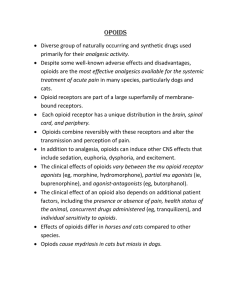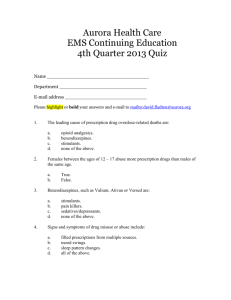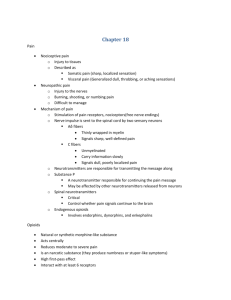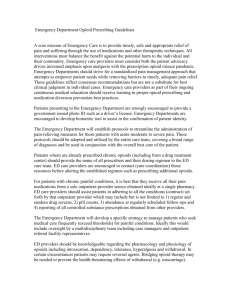Pain: Clinical Update - Volume 23 - Number 6
advertisement
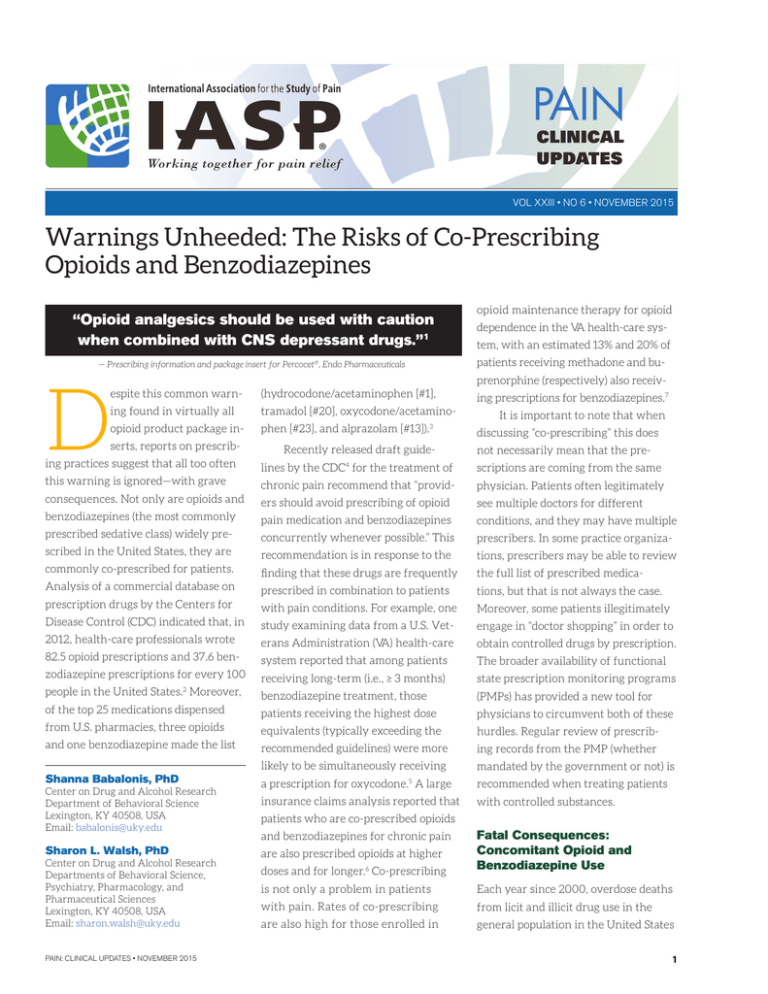
® • NO • JUNE 2013 2015 VOL VOL XXIIIXXI • NO 6 •1NOVEMBER Warnings Unheeded:Vol.ÊXXI,ÊIssueÊ1Ê The Risks of Co-Prescribing Editorial Board Opioids and Benzodiazepines JuneÊ2013 PsychosocialÊAspectsÊofÊChronicÊPelvicÊPain Editor-in-Chief JaneÊC.ÊBallantyne,ÊMD,ÊFRCA Anesthesiology,ÊPainÊMedicine USA opioid maintenance therapy for opioid “Opioid analgesics should be used with caution dependence in the VA health-care sys1 when combined with CNSPain depressant is unwanted, isdrugs.” unfortunately common, remains essential forand survival (i.e., tem,and with an estimated 13% 20% of AdvisoryÊBoard evading danger) and facilitating medical diagnoses. This complex amalgamation patients receiving methadone and bu- of sensation, emotions, and thoughts manifests itself as pain behavior. Pain is a motiprenorphine (respectively) also receiv- 1 and for emergency department visits and is vating factor for physician consultations (hydrocodone/acetaminophen [#1], 7 — Prescribing information and package insert for Percocet®, Endo Pharmaceuticals MichaelÊJ.ÊCousins,ÊMD,ÊDSC PainÊMedicine,ÊPalliativeÊMedicine Australia espite this common D warn- ing prescriptions for benzodiazepines. ing found in virtually all tramadol [#20], oxycodone/acetamino- opioid product package in- phen [#23], and alprazolam [#13]).3 serts, reports on prescrib- Recently released draft guide- It is important to note that when discussing “co-prescribing” this does not necessarily mean that the pre- ing practices suggest that all too often lines by the CDC4 for the treatment of scriptions are coming from the same this warning is ignored—with grave chronic pain recommend that “provid- physician. Patients often legitimately consequences. Not only are opioids and ers should avoid prescribing of opioid see multiple doctors for different benzodiazepines (the most commonly pain medication and benzodiazepines conditions, and they may have multiple prescribed sedative class) widely pre- concurrently whenever possible.” This prescribers. In some practice organiza- scribed in the United States, they are recommendation is in response to the tions, prescribers may be able to review commonly co-prescribed for patients. finding that these drugs are frequently the full list of prescribed medica- Analysis of a commercial database on prescribed in combination to patients tions, but that is not always the case. prescription drugs by the Centers for with pain conditions. For example, one Moreover, some patients illegitimately Disease Control (CDC) indicated that, in study examining data from a U.S. Vet- engage in “doctor shopping” in order to 2012, health-care professionals wrote erans Administration (VA) health-care obtain controlled drugs by prescription. 82.5 opioid prescriptions and 37.6 ben- system reported that among patients The broader availability of functional zodiazepine prescriptions for every 100 receiving long-term (i.e., ≥ 3 months) state prescription monitoring programs people in the United States.2 Moreover, benzodiazepine treatment, those (PMPs) has provided a new tool for of the top 25 medications dispensed patients receiving the highest dose physicians to circumvent both of these from U.S. pharmacies, three opioids equivalents (typically exceeding the hurdles. Regular review of prescrib- and one benzodiazepine made the list recommended guidelines) were more ing records from the PMP (whether likely to be simultaneously receiving mandated by the government or not) is a prescription for oxycodone.5 A large recommended when treating patients insurance claims analysis reported that with controlled substances. Shanna Babalonis, PhD Center on Drug and Alcohol Research Department of Behavioral Science Lexington, KY 40508, USA Email: babalonis@uky.edu Sharon L. Walsh, PhD Center on Drug and Alcohol Research Departments of Behavioral Science, Psychiatry, Pharmacology, and Pharmaceutical Sciences Lexington, KY 40508, USA Email: sharon.walsh@uky.edu PAIN: CLINICAL UPDATES • NOVEMBER 2015 patients who are co-prescribed opioids doses and for longer.6 Co-prescribing Fatal Consequences: Concomitant Opioid and Benzodiazepine Use is not only a problem in patients Each year since 2000, overdose deaths with pain. Rates of co-prescribing from licit and illicit drug use in the are also high for those enrolled in general population in the United States and benzodiazepines for chronic pain are also prescribed opioids at higher 1 have increased.8 The 12-year span One alarming study from Canada to untoward outcomes, including death, from 2001 to 2013 saw a three-fold reported that in a cohort of chronic pain when taken in combination. Given the increase in deaths involving prescrip- patients who died of a drug overdose many different drugs within both the tion opioids. Although prescription with opioids, 85% were co-prescribed opioid and benzodiazepine classes, each opioids contribute to the highest rates a benzodiazepine that was detected with a unique structure, pharmacologi- of overdose deaths, benzodiazepines in body fluids at death. Similarly, cal action (i.e., intrinsic efficacy, po- have also been implicated. Data from in a population of VA patients being tency, receptor binding characteristics), 2010 suggest that nearly 60% of over- treated with opioids for acute, chronic, and metabolic pathway, it is likely that dose deaths were due to a prescription or nonterminal cancer pain who died multiple factors are at play, both phar- drug (rather than illicit drugs), with from an opioid overdose, 49% died while macodynamic and pharmacokinetic, prescription opioids contributing to they had active prescriptions for both when the drugs are taken in combina- the greatest number of deaths at 75%, opioids and benzodiazepines, translat- tion. While it is impossible to identify while benzodiazepines contributed to ing to a 3.86 odds ratio increase of death a single mechanism of action that may approximately 29%. compared with those who were only lead to additive or synergistic actions, prescribed opioids. When controlling it is informative to review the available 9 10 11 for opioid dose (which independently data and to appreciate the numerous Patients filling both opioid and significantly contributes to over- possible mechanisms underlying these and benzodiazepine dose death rates), the authors found potential interactions (see Table 1). prescriptions had a 15-fold that benzodiazepine dose contributed increase in the risk of death compared with those filling neither prescription. In populations of patients taking prescription opioids for the treatment of pain (particularly chronic pain), the risk of overdose is a serious concern.11 Although several factors may contribute to this risk (e.g., opioid dose, comorbid respiratory conditions), one of the greatest risks is from concomitant to risk, with a three-fold increase in risk of death in those receiving the Given the many different highest benzodiazepines doses (>40 mg drugs within both the opioid diazepam equivalents) compared with and benzodiazepine classes, those receiving opioids with low doses it is likely that multiple of benzodiazepines (>0–10 mg).14 Finally, national data collected from 2003 to 2009 identified oxycodone and alpra- the drugs are taken in zolam as the two prescription drugs combination. with the greatest increases in associated death rates (i.e., increases of 265% and 234%, respectively).15 opioids and benzodiazepines increased 14% per year from 2006 to 2011.12 In one study from West Virginia, fill- Benzodiazepines have a remarkable safety margin and have rarely been attributed as the sole reason for use of benzodiazepines. In the United States, deaths from co-prescribed factors are at play when Pharmacological Interactions Between Opioids and Benzodiazepines: Potential Mechanisms of Action overdose death (e.g., see review by Gaudreault and colleagues16). Mu-opioid agonists reliably reduce respiratory ing an opioid prescription in the six Because so few controlled months prior to death increased the studies have directly exam- risk of drug overdose death three-fold, ined the nature of the inter- Table 1 Opioid and benzodiazepine interactions: potential mechanisms of action in overdose compared with filling a prescription for action between opioids and Metabolic drug-drug interactions a non-opioid/non-benzodiazepine con- benzodiazepines (or other trolled drug. Those filling a prescription sedatives for that matter), for a benzodiazepine had a seven-fold the available data do not Genetic differences in sensitivity increase in death. Critically, patients clearly define the spe- Changes in drug transport (e.g., p-glycoprotein) filling both opioid and benzodiazepine cific mechanisms of action Muscle relaxant effects in throat/airway prescriptions had a 15-fold increase in whereby opioids and ben- Exacerbation of sleep apnea the risk of death compared with those zodiazepines, despite being Loss of tolerance (e.g., interrupted therapy) filling neither prescription.13 safe when given alone, lead 2 Altering parent drug concentrations Altering active metabolite concentrations PAIN: CLINICAL UPDATES • NOVEMBER 2015 of drug-drug interactions occurring at Benzodiazepines have a the point of drug metabolism (usually remarkable safety margin in the liver), with at least two sce- and have rarely been attributed as the sole reason for overdose death. narios that may lead to enhanced drug concentrations and action. The first example would be where Drug 1 acts as an inhibitor of the enzyme responsible for metabolism of Drug 2; thus, in function; this effect is dose-dependent, the presence of Drug 1, the metabolism and tolerance can develop to this effect of Drug 2 is decreased or blocked and in patients who take opioids on a chron- concentrations of Drug 2 are higher ic basis. Mu-opioid receptors are found than expected. This scenario is espe- in high concentrations in the respira- cially problematic when drugs with a tory control center of the brain in the long half-life are used (e.g., methadone) medulla. These chemoreceptors actively and the introduction of an enzyme monitor O2 and CO2 concentrations inhibitor or enzyme competitor may circulating in blood and provide a feed- lead to ever-increasing concentrations back mechanism to modify respiratory of Drug 1. function (frequency, depth) to maintain The second example would be Editorial Board Editor-in-Chief Jane C. Ballantyne, MD, FRCA Anesthesiology, Pain Medicine USA Advisory Board Michael J. Cousins, MD, DSC Pain Medicine, Palliative Medicine Australia Maria Adele Giamberardino, MD Internal Medicine, Physiology Italy Robert N. Jamison, PhD Psychology, Pain Assessment USA Patricia A. McGrath, PhD Psychology, Pediatric Pain Canada M.R. Rajagopal, MD Pain Medicine, Palliative Medicine India homeostatic oxygen concentrations. where Drug 1 is an inducer of the Mu-opioid agonist binding essentially enzyme responsible for the metabolism dampens or dulls the sensitivity of of Drug 2 and Drug 2 exerts a signifi- these chemoreceptors to CO2, reduc- cant amount of its activity through a ing the responsiveness of the system. secondary active metabolite. In that in- Thus, low doses of an opioid given to an stance, the introduction of the enzyme Harriët M. Wittink, PhD, PT opioid-naive individual may lead to a inducer leads to greater concentrations modest reduction in respiratory mark- Physical Therapy The Netherlands of the active metabolite than expected. ers (respiratory rate, tidal volume) but As opioids often share structural simi- have no clinically significant effect. In larities (with a few exceptions, which contrast, supratherapeutic doses given are usually the synthetic opioids), to an opioid-naive individual may lead many opioids are substrates for the to respiratory failure, which is typically same or overlapping P450 enzymes. the assigned cause of death in opioid The same is true for the benzodiaze- overdose. The physiology of respiration pines, whereby individual agents share is obviously more complicated than the structural similarities within class (and simple system described here, and for also often share the same long-acting further discussion we recommend a metabolites). In addition, the metabo- thorough review by White and Irvine.17 lism of several opioids and benzodiazepines leads to the formation of active Biological Interactions: Enzymes, Transporters, and Channels metabolites that may exert pharma- One obvious potential mechanism pharmacokinetic studies of drug con- of additive or synergistic action is centrations in plasma, it is important through a simple pharmacokinetic to recognize that concentrations at the interaction whereby the presence of site of action (e.g., the brain) may be one drug increases the concentration quite different and may reflect local of a second agent. We typically think metabolism in the brain rather than PAIN: CLINICAL UPDATES • NOVEMBER 2015 codynamic effects. While drug-drug interactions are often revealed through Maree T. Smith, PhD Pharmacology Australia Claudia Sommer, MD Neurology Germany Publishing Daniel J. Levin, Publications Director Elizabeth Endres, Consulting Editor Timely topics in pain research and treatment have been selected for publication, but the information provided and opinions expressed have not involved any verification of the findings, conclusions, and opinions by IASP. Thus, opinions expressed in Pain: Clinical Updates do not necessarily reflect those of IASP or of the Officers or Councilors. No responsibility is assumed by IASP for any injury and/or damage to persons or property as a matter of product liability, negligence, or from any use of any methods, products, instruction, or ideas contained in the material herein. Because of the rapid advances in the medical sciences, the publisher recommends independent verification of diagnoses and drug dosages. © Copyright 2015 International Association for the Study of Pain. All rights reserved. For permission to reprint or translate this article, contact: International Association for the Study of Pain 1510 H Street NW, Suite 600, Washington, D.C. 20005-1020, USA Tel: +1-202-524-5300 Fax: +1-202-524-5301 Email: iaspdesk@iasp-pain.org www.iasp-pain.org 3 the liver (e.g., see review by Pai et al.18). However, to understand the potential risk for drug-drug metabolic interac- Table 2 Drug metabolism mediated by cytochrome P450 (CYPs) tions, it is essential to at least know the Opioid Analgesics Benzodiazepines specific metabolic pathways for each of Oxycodone 3A4, 2D6 oxymorphone (2D6) Alprazolam 3A4, 3A5 α-hydroxyalprazolam (3A4) 4-hydroxyalprazolam (3A5) the agents prescribed. Table 2 provides an overview (but not an exhaustive list) of commonly prescribed opioids and benzodiazepines along with their known hepatic metabolic pathways and also notes whether their metabolism leads to known active metabolites. Another pharmacokinetic mechanism that can produce clinically relevant drug-drug interactions is through the superfamily of ATP- Hydromorphone 3A4, 2D6 Morphine 3A4, 2C8 Codeine 3A4, 2D6 morphine (2D6) Tramadol 3A4, 2D6 o-desmethyltramadol (2D6) Midazolam 3A4, 3A5, 3A3 α-hydroxymidazolam (3A4) Triazolam 3A4 Diazepam 3A4, 2C19 desmethyldiazepam (2C19) Clonazepam 3A4, 2C19 Methadone 3A4, 2B6, 2D6, 1A2 binding cassette (ABC) protein transporters of which P-glycoprotein (P-gp) is probably the best characterized. P-gp transporters play a critical role in drug efflux and are found in tissues that act as biological barriers, including the blood-brain barrier and epithelial cells of the liver, kidneys, and intestines (see Silva et al.19 for a recent interesting review). Thus, P-gp plays a critical role in controlling the movement and concentrations of drugs by limiting both their absorption and their transport out of the brain. There are at least two compelling illustrative examples of clinically relevant P-gp effects on opioid responses. Loperamide, an opioid used for the treatment of diarrhea, is a substrate for P-gp and is, therefore, largely prevented from crossing the bloodbrain barrier (rendering it essentially a peripherally acting opioid). In a study by Sadeque and colleagues,20 loperamide was administered to healthy adults alone and produced no respiratory depression (as expected, given the central mediation of opioid-induced respiratory depression). However, when given in combination with quinidine, a substrate known to inhibit P-gp transport, loperamide produced significant 4 Fentanyl 3A4 Hydrocodone 3A4, 2D6 hydromorphone (2D6) Buprenorphine 3A4, 2C8 norbuprenorphine (3A4) Commonly prescribed opioid and benzodiazepine medications are listed along with the P450 CYP enzymes involved in hepatic metabolism of each compound. Active metabolites are listed in italicized text underneath the parent drug (when applicable). P450 CYP3A4 is highlighted in blue throughout the table to highlight this common metabolic pathway. This table was adapted from several comprehensive sources.37-42 respiratory depression, presumably by demonstrated that buprenorphine ad- quinidine inhibition of P-gp allowing ministration produced limited changes for loperamide entry into the brain. in respiratory function when given The second illustrative study alone. However, when given in the focused on buprenorphine, a partial presence of a P-gp inhibitor or when opioid agonist that produces a rela- given to P-gp knockout mice (i.e., tively flat dose-response function, mice genetically engineered to lack even at very high doses. Buprenor- the P-gp transporter), buprenorphine phine is recognized for its wide caused respiratory depression that therapeutic window and low risk of was fatal in some cases.22 The authors opioid overdose when given alone. demonstrated that inhibition of P-gp Buprenorphine also has an active precluded norbuprenorphine, the metabolite, norbuprenorphine, which more potent respiratory depressant, may have limited functional activity from exiting the brain, as evidenced in humans with therapeutic dosing by substantially higher concentrations but has been demonstrated in preclini- of norbuprenorphine in the brain cal studies to have greater potency as compartment after pretreatment with a respiratory depressant compared the P-gp inhibitor, as compared with to the parent drug. A study in mice placebo. These studies demonstrate 21 PAIN: CLINICAL UPDATES • NOVEMBER 2015 clearly that changes in drug transport cardiac monitoring,23,24 although this may be a source of significant drug- is not without some controversy (see produces dose-dependent sedative drug interactions, but one that may be Krantz et al.25 and related subsequent effects; however, dose combinations, difficult to predict in patients. published commentary). Importantly, co-prescribed or co-abused, produce some studies have suggested that the enhanced, often synergistic effects tially risky drug-drug interactions is QTc interval prolongation observed of psychomotor impairment, declines the hERG channel (human ether-a- with methadone may be prolonged in cognitive abilities, increases in go-go-related gene), a potassium ion further in the presence of benzodi- sedation, and decreases in arousabil- channel that is known to play an azepines (e.g., see Peles et al.26). Thus, ity. Several controlled studies have important role in QTc prolongation awareness of cardiac risk factors and examined the behavioral and other and to increase the risk of the rare but ECG evaluation prior to initiating interactions of these two drug classes often fatal heart arrhythmia known as treatment or before adding other QTc- in healthy research participants (e.g., torsades de pointes. QTc prolongation prolonging drugs should be considered no histories of chronic obstructive has received extensive attention in as a potential preemptive strategy for pulmonary disease or heart disease). pharmaceutical development because reducing risks to patients. For example, one study27 explored the A third relevant site for poten- many drugs have been shown to Each drug, administered alone, pharmacodynamic effects of a single high dose of diazepam (40 mg, a dose trocardiogram (ECG); thus, develop- Behavioral Risks: Another Pharmacodynamic Concern ment plans for new drugs commonly Most opioids used for pain management starting dose) in participants receiving require cardiac studies. produce their behavioral and phar- maintenance doses of either metha- macological effects primarily through done or buprenorphine for opioid use done is probably the most studied mu-opioid receptor activation, causing disorder. Placebo or diazepam chal- and widely reported opioid with dose-dependent sedation, respiratory lenges were tested with the normal documented effects on QTc prolon- depression, and analgesia. Benzodi- maintenance dose and 150% of the gation,23 which led to a black box azepines, which are positive allosteric opioid maintenance dose during each warning related to QTc prolongation modulators of GABA-α receptors of four sessions. The results indicated and serious arrhythmias. This caveat (ligand-gated chloride channels), pro- that diazepam increased participant has led several professional societies duce cognitive and motor impairment, ratings of sedation and produced to develop new clinical guidelines for as well as anxiolytic, muscle relaxant, impairment on laboratory measures the use of methadone and recommend sleep-inducing, and antiepileptic effects. of psychomotor function, including increase the QRS complex on elec- With regard to opioids, metha- 20 times higher than the clinical Inside the Black Box: Identifying Patients at Risk - Does your patient have a history of alcohol use? - Does your patient have a history of drug abuse or misuse? If yes: Have you completed a urine drug screen? - Have you tried nonopioid analgesics? - Have you considered nonbenzodiazepine medications for anxiety and/or sleep? - Have you read the package insert for each prescribed drug? - Do you always start at the lowest dose (e.g., start low and go slow)? - Have you accessed the patient’s record in a prescription monitoring database? If yes: Are any other providers prescribing opioids, benzodiazepines, or contraindicated medications? - Have you counseled your patient about the risks? PAIN: CLINICAL UPDATES • NOVEMBER 2015 5 reaction time and speed and accuracy tests.27 These effects were largely There are rational and clinically judicious reasons why independent of opioid dose, with high- opioids and benzodiazepines are co-prescribed. dose diazepam impairment occurring in both methadone- and buprenor- benzodiazepines are co-prescribed. loud snoring, or behavioral impair- phine-maintained subjects. However, Patients with chronic pain have ment). Patients should be monitored these dose combination effects do not higher incidence rates of depression, for misuse (e.g., taking higher doses appear to be driven by pharmaco- anxiety, and difficulties with sleep, than than prescribed or taking drugs kinetic interactions. Two controlled which may explain why these agents by a different route of administration), studies have examined acute and re- are so commonly co-prescribed in this and calls for early refills should raise a peated dose combinations29 of metha- population. However, some of the con- red flag. done and diazepam, and both studies ditions that warrant treatment with found no changes in the plasma levels benzodiazepines (e.g., anxiety disor- tion and overdose prevention training of the parent drugs or metabolites or ders) are also independent risk factors should be considered, as this tool be- their time course-concentration pro- for opioid overdose.32 Thus, starting comes more readily available for pre- file. Post-mortem blood samples taken doses should be conservative, and any scribing physicians.33 Although the ef- from individuals with fatal overdose dose increase should be accompanied ficacy of opioids and benzodiazepines have yielded similar findings. by extra monitoring (even if by phone) for the treatment of their respective to assess safety. indications is likely to encourage their 28 28 30, 31 These studies not only have implications for opioid-benzodiazepine Physicians may consider alterna- Naloxone overdose kit distribu- continued widespread clinical use, the overdose, but also raise concerns tive agents for sleep (e.g., zolpidem or decision to start one in the presence for increased risk of accidents from trazodone), but should be aware that of the other should be made with cau- daily activities, including risk of most sedatives, regardless of class, tion and thoughtfulness. Some clini- falls, workplace accidents, and motor have the potential to potentiate opioid cians recommend never using opioids vehicle accidents, as well as increased sedation, and that few controlled data and benzodiazepines in combination, concern for patients engaging in exist to inform their preferential use given the difficulty of weaning should sports and outdoor activities or caring and safety. Physicians should be famil- adverse effects arise. Vigilance is for children, particularly in patients iar with the risk of drug-drug interac- warranted if co-prescribing opioids who have limited experience with the tions for the agents they prescribe and and benzodiazepines, and a cautious impairing effects of these medications. should be counseling their patients and integrated approach should be accordingly so that they and their taken whenever combined therapy is Recommendations family members are aware of the signs needed for the treatment of comorbid There are rational and clinically of potential opioid toxicity (e.g., “nod- disorders.34-36 judicious reasons why opioids and ding” off or oversedation, unusually 6 PAIN: CLINICAL UPDATES • NOVEMBER 2015 References 23.Chou R, Cruciani RA, Fiellin DA, Compton P, Farrar JT, Haigney MC, In- Percocet®. Malvern, PA; 2015. turrisi C, Knight JR, Otis-Green S, Marcus SM, Mehta D, Meyer MC, Portenoy R, Savage S, Strain E, Walsh S, Zeltzer L; American Pain Society; Heart Rhythm Society. 2. Paulozzi LJ, Mack KA, Hockenberry JM. Vital signs: variation among 24.Martin JA, Campbell A, Killip T, Kotz M, Krantz MJ, Kreek MJ, McCar- 1. Endo Pharmaceuticals. Prescribing information and package insert for states in prescribing of opioid pain relievers and benzodiazepines—United States, 2012. MMWR Morb Mortal Wkly Rep 2014;63:563–8. Available at: http://www.cdc.gov/mmwr. 3. IMS Institute for Health Care Informatics. Avoidable Costs in U.S. health- roll BA, Mehta D, Payte JT, Stimmel B, Taylor T, Haigney MC, Wilford BB; Substance Abuse and Mental Health Services Administration. QT interval screening in methadone maintenance treatment: report of a SAMHSA expert panel. J Addict Dis 2011;30:283–306. care: the $200 billion opportunity from using medicines more responsibly. 2014. 25.Krantz MJ, Martin J, Stimmel B, Mehta D, Haigney MC. QTc interval 4. Centers for Disease Control and Prevention, National Center for Injury 26.Peles E, Linzy S, Kreek MJ, Adelson M. Prospective study of QTc changes Prevention and Control, Division of Unintentional Injury Prevention. Draft CDC guidelines for prescribing opioids for chronic pain. 2015. Available at: http://www.cdc.gov/drugoverdose/prescribing/guideline.html. 5. Hermos JA, Young MM, Lawler EV, Stedman MR, Gagnon DR, Fiore LD. screening in methadone treatment. Ann Intern Med 2009;150:387–95. among former opiate addicts since admission to methadone maintenance treatment: benzodiazepine risk. J Addict Med 2013;7:428–34. 27.Lintzeris N, Mitchell TB, Bond AJ, Nestor L, Strang J. Pharmacodynam- Characterizations of long-term anxiolytic benzodiazepine prescriptions in veteran patients. J Clin Psychopharmacol 2005;25:600–4. ics of diazepam co-administered with methadone or buprenorphine under high dose conditions in opioid dependent patients. Drug Alcohol Depend 2007;91:187–94. 6. Paulozzi LJ, Zhang K, Jones CM, Mack KA. Risk of adverse health out- 28.Preston KL, Griffiths RR, Cone EJ, Darwin WD, Gorodetzky CW. Diaz- comes with increasing duration and regularity of opioid therapy. J Am Board Fam Med 2014;27:329–38. 7. Park TW, Bohnert AS, Austin KL, Saitz R, Pizer SD. Datapoints: regional variation in benzodiazepine prescribing for patients on opioid agonist therapy. Psychiatr Serv 2014;65:4. 8. Centers for Disease Control and Prevention. National Center for Health Statistics, data on drug poisoning deaths. 2015. Available at: http://www.cdc. gov/nchs. 9. Centers for Disease Control and Prevention. National overdose deaths from select prescription and illicit drugs; CDC WONDER Database. 2015. Available at: http://wonder.cdc.gov/mcd.html. epam and methadone blood levels following concurrent administration of diazepam and methadone. Drug Alcohol Depend 1986;18:195–202. 29.Pond SM, Tong TG, Benowitz NL, Jacob P 3rd, Rigod J. Lack of effect of diazepam on methadone metabolism in methadone-maintained addicts. Clin Pharmacol Ther 1982;31:139–43. 30.Fields MD, Abate MA, Hu L, Long DL, Blommel ML, Haikal NA, Kraner JC. Parent and metabolite opioid drug concentrations in unintentional deaths involving opioid and benzodiazepine combinations. J Forensic Sci 2015;60:950–6. 31. Rogers WO, Hall MA, Brissie RM, Robinson CA. Detection of alpra- 10.Jones CM, Mack KA, Paulozzi LJ. Pharmaceutical overdose deaths, United zolam in three cases of methadone/benzodiazepine overdose. J Forensic Sci 1997;42:155–6. States, 2010. JAMA 2013;309:657–9. 32.Saunders KW, Von Korff M, Campbell CI, Banta-Green CJ, Sullivan 11. Gomes T, Mamdani MM, Dhalla IA, Paterson JM, Juurlink DN. Opioid dose and drug-related mortality in patients with nonmalignant pain. Arch Intern Med 2011;171:686–91. MD, Merrill JO, Weisner C. Concurrent use of alcohol and sedatives among persons prescribed chronic opioid therapy: prevalence and risk factors. J Pain 2012;13:266–75. 12. Chen LH, Hedegaard H, Warner M. Drug-poisoning deaths involving 33.Coe MA, Walsh SL. Distribution of naloxone for overdose prevention to opioid analgesics: United States, 1999–2011. NCHS Data Brief 2014(166):1–8. chronic pain patients. Prev Med 2015;80:41–3. 13. Peirce GL, Smith MJ, Abate MA, Halverson J. Doctor and pharmacy shop- 34.Jones JD, Mogali S, Comer SD. Polydrug abuse: a review of opioid and ping for controlled substances. Med Care 2012;50:494–500. benzodiazepine combination use. Drug Alcohol Depend 2012;125:8–18. 14.Park TW, Saitz R, Ganoczy D, Ilgen MA, Bohnert AS. Benzodiazepine 35.Altamura AC, Moliterno D, Paletta S, Maffini M, Mauri MC, Bareggi S. prescribing patterns and deaths from drug overdose among US veterans receiving opioid analgesics: case-cohort study. BMJ 2015;350:h2698. Understanding the pharmacokinetics of anxiolytic drugs. Expert Opin Drug Metab Toxicol 2013;9:423–40. 15. Jann M, Kennedy WK, Lopez G. Benzodiazepines: a major component in 36.Webster LR, Cochella S, Dasgupta N, Fakata KL, Fine PG, Fishman unintentional prescription drug overdoses with opioid analgesics. J Pharm Pract 2014;27:5–16. 16. Gaudreault P, Guay J, Thivierge RL, Verdy I. Benzodiazepine poisoning. Clinical and pharmacological considerations and treatment. Drug Saf 1991;6:247–65. 17. White JM, Irvine RJ. Mechanisms of fatal opioid overdose. Addiction. 1999;94:961–72. 18. Pai HV, Upadhya SC, Chinta SJ, Hegde SN, Ravindranath V. Differential metabolism of alprazolam by liver and brain cytochrome (P4503A) to pharmacologically active metabolite. Pharmacogenomics J 2002;2:243–58. 19. Silva R, Vilas-Boas V, Carmo H, Dinis-Oliveira RJ, Carvalho F, de Lourdes Bastos M, Remião F. 20.Sadeque AJ, Wandel C, He H, Shah S, Wood AJ. Increased drug delivery to the brain by P-glycoprotein inhibition. Clin Pharmacol Ther 2000;68:231–7. 21. Walsh SL, Preston KL, Stitzer ML, Cone EJ, Bigelow GE. Clinical pharma- SM, Grey T, Johnson EM, Lee LK, Passik SD, Peppin J, Porucznik CA, Ray A, Schnoll SH, Stieg RL, Wakeland W. An analysis of the root causes for opioid-related overdose deaths in the United States. Pain Med 2011;12(Suppl 2):S26–35. 37.Lazo JS, Parker KL. Goodman & Gilman’s The pharmacological basis of therapeutics. McGraw-Hill Publishing; 2005. 38.Fukasawa T, Suzuki A, Otani K. Effects of genetic polymorphism of cytochrome P450 enzymes on the pharmacokinetics of benzodiazepines. J Clin Pharm Ther 2007;32:333–41. 39.Chouinard G, Lefko-Singh K, Teboul E. Metabolism of anxiolytics and hypnotics: benzodiazepines, buspirone, zoplicone, and zolpidem. Cell Mol Neurobiol 1999;19:533–52. 40.Maurer HH, Sauer C, Theobald DS. Toxicokinetics of drugs of abuse: current knowledge of the isoenzymes involved in the human metabolism of tetrahydrocannabinol, cocaine, heroin, morphine, and codeine. Ther Drug Monit 2006;28:447–53. cology of buprenorphine: ceiling effects at high doses. Clin Pharmacol Ther 1994;55:569–80. 41.Smith HS. Opioid metabolism. Mayo Clin Proc 2009;84:613–24. 22.Alhaddad H, Cisternino S, Declèves X, Tournier N, Schlatter J, Chiadmi F, gic activity: neuropharmacological effects of benzodiazepines and therapeutic use in anesthesiology. Pharmacol Rev 2011;63:243–67. Risède P, Smirnova M, Besengez C, Scherrmann JM, Baud FJ, Mégarbane B. Respiratory toxicity of buprenorphine results from the blockage of P-glycoprotein-mediated efflux of norbuprenorphine at the blood-brain barrier in mice. Crit Care Med. 2012;40:3215–23. PAIN: CLINICAL UPDATES • NOVEMBER 2015 42.Saari TI, Uusi-Oukari M, Ahonen J, Olkkola KT. Enhancement of GABAer- 7
